Aliyah Bet & Machal Virtual Museum
North American Volunteers In Israel's War of Independence
Pictorial History: Aiding the Ground Forces
American and Canadian volunteers served in virtually every unit of the Israeli army, contributing military expertise that many had learned in combat in World War II. The approximately 500 volunteers were a distinct minority in the Israeli army that had begun the war with about 30,000 men and women. The men and women of Machal provided important specialized skills in armor, weaponry, equipment maintenance, medical aid, signals, and key positions of command.
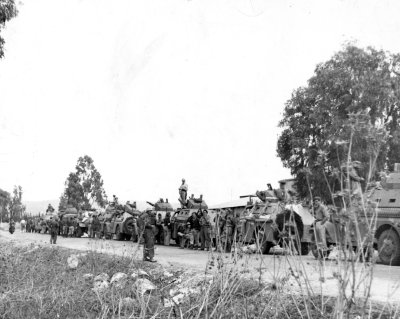
Photo courtesy Frank Perlman family
Deployed for Battle
A line of armored cars from the 7th Brigade’s 79th Armored Battalion lines up at roadside awaiting the command to move forward. About half of the Americans and Canadians in the army were assigned to the 7th Brigade, which was sometimes called the “Anglo-Saxon Brigade” because of the large number of North Americans, South Africans, and Englishmen in its ranks. These armored cars were made in Israel.
English-Speaking Crew
This armored car crew in the 79th Armored Battalion had a typical “Anglo-Saxon” flavor: top to bottom, Jack Gold, 29, Montreal; Frank Perlman, 28, Pittsburgh; and Solly Ossin, Johannesburg, South Africa.
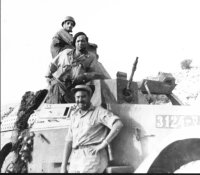
Photo courtesy Frank Perlman family
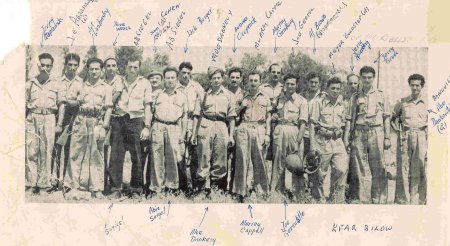
Canadian Machalniks
A number of Canadians, mostly from Toronto, are shown at Kfar Bilu, a moshav near Rehovot, in July 1948. Many of these men served in a separate Canadian fighting platoon in the 52nd Battalion of the Givati Brigade

West Point Graduate
David “Mickey” Marcus, 47, held the highest command position of any American volunteer. A West Point graduate, the native of Manhattan’s Lower East Side had parachuted into Normandy with the 10lst Airborne Division on D-Day. He wrote Israel’s first field manual, and was named commander of the Jerusalem front by David Ben-Gurion – he was the first officer to receive the new rank of “aluf” (brigadier general). He was accidentally killed by his own sentry during the successful battle to open the road to surrounded Jerusalem.
Canadian Brigadier
Ben Dunkelman, 48, a battlefield commander in the Royal Canadian Army during World War II, recruited the first Canadian volunteers for the Israeli armed forces, then joined them in Israel. He was the highest ranked Canadian. He served as a Palmach officer on the Jerusalem front, then became brigadier (commanding officer) of the 7th Brigade. He directed Operation Hiram, which routed Lebanese, Syrian, and Iraqi invasion forces in the Central and Upper Galilee in late October 1948 and secured that area as a permanent part of the Jewish state.
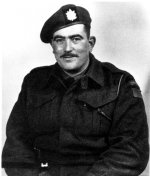

Gloria Kessler Pelzig photo
North Americans in Medical Corps
Gloria Kessler, 24, of Chicago was one of a dozen nurses and another dozen medical doctors from the United States and Canada who volunteered to serve in Israeli army hospitals and front-line medical units. Most had military medical experience from World War II.
Only Native-American
Jesse Slade, from Oklahoma, was the only Native-American to serve with Machal. A member of the 4th Troop, 1st Anti-Tank, 421st Artillery Regiment, Negev Brigade, he said he joined because of his respect for a Jewish officer during World War II. “He was the first guy to treat me like a white man.”
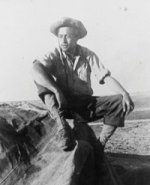
Jesse Slade
Photo courtesy Dr. Jason Fenton
Victory Ribbon
Veterans of the War of Independence were entitled to wear this campaign ribbon. In addition, those who served in Machal and pre-war Haganah were awarded the small menorah, “Decoration of State Warriors,” as a clasp on the campaign ribbon. The campaign ribbon shown was awarded posthumously to Bilha Zibersky, 21, of Jerusalem, an armored car radio operator in the Jerusalem Brigade. A Hebrew University student, she was killed on April 9, 1948, in her unit’s attempt to open the road to besieged Jerusalem.
From Bilha Zibersky family


Bilha Zibersky

Artifacts contributed by Ralph Lowenstein
Salary, $6 a Month
The monthly pay for all soldiers in the army, including the foreign volunteers, was two pounds a month. One Palestine Pound was worth about $3. The name “Israel” had not yet appeared on bills or coins. This hat and military driving license were issued to Ralph Lowenstein, 18, who was made a halftrack driver immediately after induction, since he had a driving license in the state of Virginia since the age of 13. A Columbia University sophomore, he went into combat with his unit 10 days after arriving in Israel. Lowenstein was later in life one of the longest-serving deans in the history of the University of Florida, heading the College of Journalism and Communications for 18 years, 1976-1994.
An Extra-Hard Mattress
A Machalnik burrows in for a night’s sleep. On base, soldiers were assigned a straw-filled mattress, two blankets, and a bed made of wooden planks. They carried the blankets into the field during battle and used them as a barrier to the cold Israeli nights and the vicious Israeli mosquitoes.
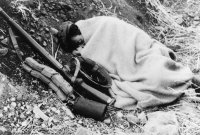
Yale Jaffe Photo

Weapons of War
Israeli troops had small arms, and little else, during most of the War of Independence. The German Mauser K98k (in back) was acquired in large numbers from Czechoslovakia. German insignia are embedded in the metal, but the sling that went with the rifle was of Israeli manufacture and bore the Israeli army “tzadic.” The Mark II Sten Gun (in front) is a 32-shot sub-machinegun of British design. Sten Guns were made in underground factories by Palestinian Jews during the British mandatory period, since they had only 47 parts.
First Tank Commander
Lionel Druker, 24, of Sydney, Nova Scotia, was the first tank commander in the history of the Israeli army. He and the tank crews he led served in the 8th Brigade against Egyptian forces in the Negev. Druker remained in Israel after the war, and, with fellow Canadian Arthur Goldberg of Vancouver, founded one of Israel’s largest travel agencies. The three tank models displayed represent Israel’s entire tank corps in the first months of the war – one American Sherman M4A3, built from pieces junked by the departing British army, and two British Cromwells delivered by two Irish soldiers who defected from the British military.
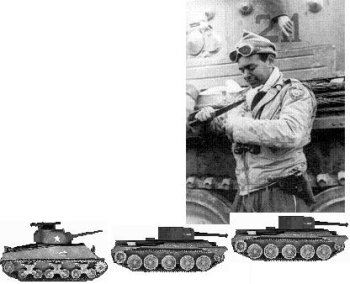
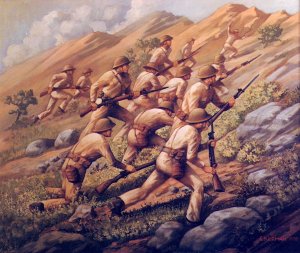
Painting courtesy Stanley Klorman family
Charge of Company B
On September 7, 1948, Company B of the 7th Brigade's 72nd Battalion was dispatched to counter an Arab advance on a hill near the village of Tamra in the Western Galilee. Company B was the only unit in the Israeli army made up totally of English-speaking volunteers. At one point in the battle, Capt. Norman Schutzman, 28, of Wilmington, Delaware, ordered his men to fix bayonets on their German rifles and rush the Arab positions atop the hill. This painting by Stanley Klorman of Los Angeles, a member of the company, depicts what is said to be the only bayonet charge in the history of the Israeli army. The hill was retaken, but one Machalnik, Sid Leisure, 19, of Toronto, was killed.
To the North
This squad of men in the 79th Armored Battalion shared the same halftrack and boasted three American volunteers, Ralph Lowenstein, 18, of Danville, Virginia (standing far left), Morton Levinson, 18, of Boston (standing, second from right), and Ivan Goode, 20, of Chicago (kneeling, center). Other members of the squad were Palestinian Jews and survivors of the Holocaust. This photo was taken in late October, 1948, shortly after the 79th captured Malkiya, background, a former British police station on the Lebanese border, and the last Arab stronghold in the Galilee. Levinson was the youngest American to serve with the armed forces, and Lowenstein was the second-youngest.
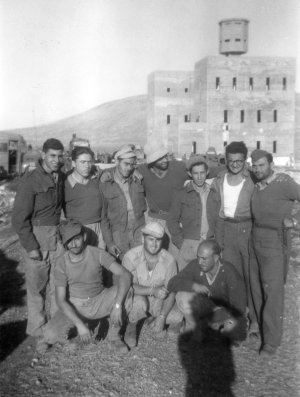
Ralph Lowenstein photo
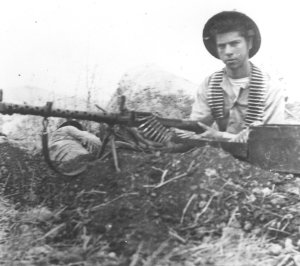
Ira Feinberg photo
To the East
Ira Feinberg, 18, of Brooklyn, was a machinegunner in the Palmach’s Yiftach Brigade, which faced the Trans-Jordan Arab Legion on the Jerusalem front. He was among the forces that successfully opened the “Burma Road,” a new passage through the mountains that broke the Arab blockade of Jerusalem. He is shown with a light machinegun of German design, manufactured in Czechoslovakia and sold in quantity to Israel by the Czechs.
To the South
Harvey Sirulnikoff (Sirlin), 20, of Winnipeg served in a Jeep company of the Palmach’s 9th Battalion in the Negev. He is the driver of the Jeep in this photo. The Jeeps, sometimes called “Samson’s Foxes,” usually mounted two machineguns, and served as the fast-moving, hard-hitting “cavalry” in an army that had virtually no armor or artillery.

Photo courtesy Harvey Sirlin family
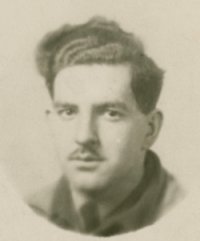
A Man For All Branches
Ben Ocopnick, 24, was the only North American to serve in Aliyah Bet and all three branches of the Israeli armed forces - the Army, Navy and Air Force. A native of Montreal, he had served in both the Royal Canadian Air Force and Royal Canadian Army during World War II. He would later say:
“We fought for the re-establishment, after nearly 2,000 years, of a Jewish State. I am sure that when I die the last thing that will pass through my mind will be what I did and others did in Israel then.” (From The Secret Army, by David Bercuson, 1983)

 Back to Aiding the Ground Forces
Back to Aiding the Ground Forces